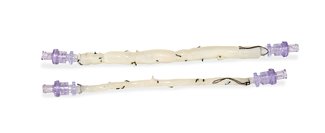CardioGraft® Pediatric Conduit

CardioGraft® Pediatric Conduit
CardioGraft Pediatric Conduit is a cryopreserved saphenous vein with competent valve for RV-PA reconstruction and cardiac shunts.
- Competent: Conduit valve identified and tested to confirm competency.
- Human Tissue: Closely resembles autograft; compliant, flexible, easy to handle and suture.
- Resistant to Infection: Natural ability to resist infection.1-3
- Convenient: Availability in various sizes to best fit the patient’s anatomy.
- Reduced Thrombosis Potential: Alleviates the need for anticoagulation therapy.3,4
- Effective: An effective option when a traditional pulmonary valve is not available.5-7
Clinical Application
- Tetralogy of Fallot
- Hypoplastic Left Heart Syndrome
- Pulmonary Valve Stenosis/Atresia
- Truncus Arteriosus
| Cryopreserved | Description | Sizing |
|---|---|---|
| PCV-C | Saphenous vein with competent valve | ≥ 6 cm/4 - 10 mm |
References
- Kirklin et al. Aortic Valve Endocarditis with Aortic Root Abscess Cavity: Surgical Treatment with Aortic Valve Homograft. Ann Thorac Surg 45:674-677, June 1988
- Tuna et al. Results of Homograft Aortic Valve Replacement for Active Endocarditis. Ann Thorac Surg 1990; 49: 619-24
- Hopkins et al. Cardiac Reconstructions with Allograft Tissues. Springer 2005
- Pettersson, Coselli, et al. 2016 The American Association for Thoracic Surgery (AATS) consensus guidelines: Surgical treatment of infective endocarditis. Journal of Thoracic and Cardiovascular Surgery, 2017; 153: 1241-1258
- Bogats, et. al. Modified Blalock-Taussig Shunt Using Allograft Saphenous Vein: Six Years’ Experience, Ann Thorac Surg 1996;61:58-62
- Schiller et al. Reconstruction of right ventricular outflow tract in neonates and infants using valved cryopreserved femoral vein homografts, The Journal of Thoracic and Cardiovascular Surgery, Volume 147, Issue 3, March 2014, Pages 874-879
- Briceno-Medina, et. al (2018). Femoral vein homograft as Sano shunt results in improved pulmonary artery growth after Norwood operation. Cardiology in the Young, 28(1), 118-125.
